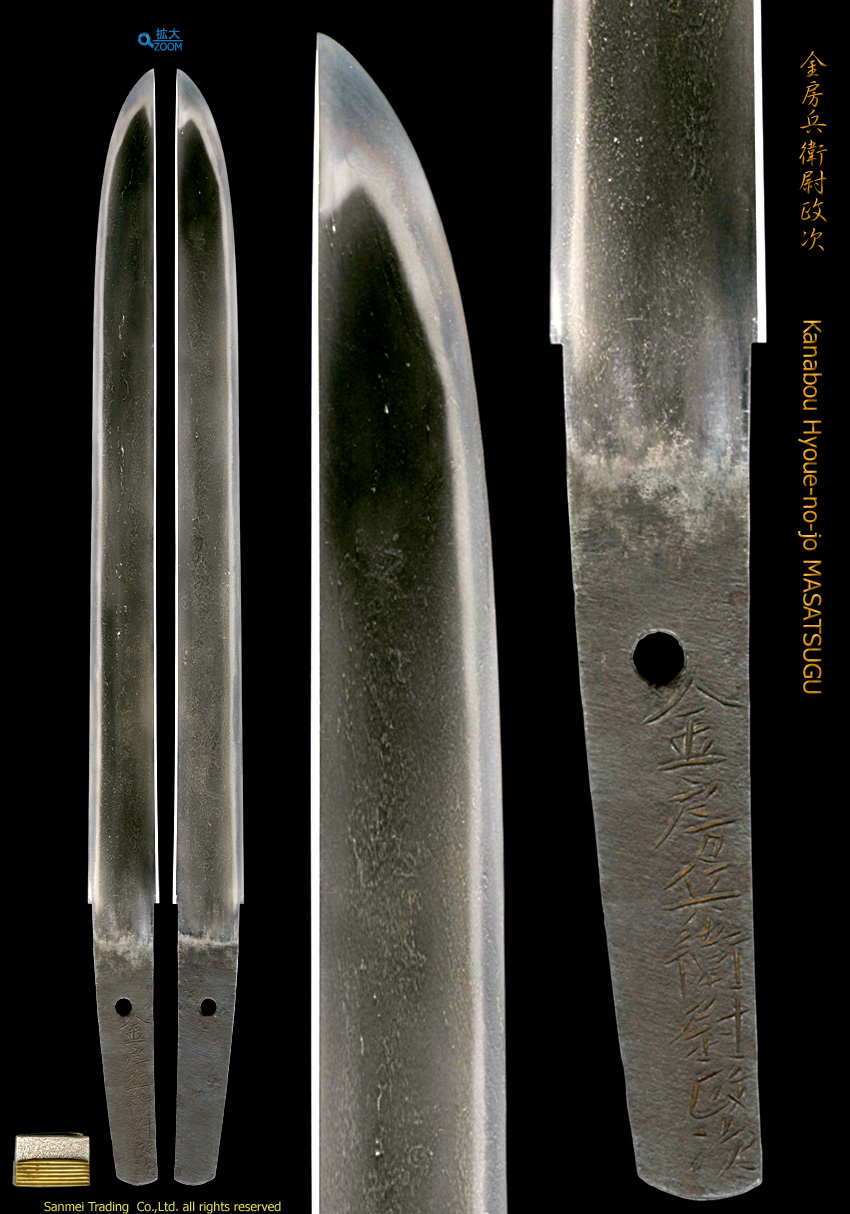Length of cutting edge 31.6cm No curvature Width of base 26.9mm Thickness of base 5.6mm
Forging(Hada): Forging is conspicuous Itame-hada mixing with Mokume in places and Masame ware appears mostly along quenching temper line. Speckled sparkling effect of misty Utsuri granules lays over above the Hamon that creates classical beauty from early 16th century.
Temper(Hamon): Hamon is a bit on coarse side Ko-Nie hard metal granules, Suguha with a slight wave indication, small Gunome, Hotsure and Niju-ha activity that runs along boundary area to convince of Yamato tradition. The interior of temper is filled with mist-like crystallize area deeply with short lines of nie Sunagashi and long line of Gin-sen thread-like areas.
Temper of tip(Boshi): Temper of boshi in front forms slight irregular lines of undulating Norare of which summit creating flame Kaen and deeply turns back and Ura the other side is sweeping up indication, large circle turns back.
Tang(Nakago): The tang is UBU original. Greatly slanting left (Ō-sujikai) filemarks. Double bevelled Kurijiri heel shape. One peg hole of Mekugi-ana. The large inscriptions of signature in front gradually becomes smaller down to heel, a name of school Kanabou 金房, the title of master Hyoue-no-jo 兵衛尉 and the name of smith MASATSUGU 政次.
Kanabou Hyoue-no-jo MASATSUGU 金房兵衛尉政次, said the head of Kanabou school in Yamato province, had been active from Tenbun to Tensho era (1532-91), reportedly in 2 generations to say descendant of Tegai branch. They exclusively worked for Buddhist military during the Warning States period.
The subject MASATSUGU 政次 had served for Houzou'in temple 宝蔵院, a branch of Koufuku-ji temple 興福寺. It is also well-known that subject maker MASATSUGU 政次 worked Ju-mon-ji cross shape spear of Yari for the master In'ei 胤栄 who established Houzou'in temple's Yari martial arts for Buddhiest warriors.
Also the Yari of Speciality Nihon-go 日本号 or Tonbo-kiri made by MASAZANE 正真, both are what comes first to our mind that they were made by the artisan of Kanabou school. Their works were mostly made bearing in mind for active service and actual utility like Yari spear, Naginata halberd or brave Tachi/Katana so that most of them had been worn out through repeated usages. Therefore subject Tanto is extraordinary work among all.
This Tanto was created in full of majestic utility that is extra large with no-curve designed for thrust and Hirazukuri-construction working well for cutting through the openings of armor or helmet. Itame forging ware of functional mixture with hard and soft steel was designed for durable construction and dimmed straight tempering was carefully quenched for the most supreme sharp performance. It is understood that this Tanto was designed as a supplemental usage for long Tachi or Katana.
Old double layers Habaki collar (lower is silver foiled and the upper is gold foiled), preserved in a new Shira-saya plain wood mounting.
Recent polish/Condition scale: very good (using a scale of mint-excellent-very good-good-fair-poor)
reference data : Honma Kunzan/Ishii Masakuni, Nihonto Meikan, Yuzankaku, 1975
note) it is written as a "Wakizashi" both in registlation and Hozon appraisal since cutting edge is more than 30cm due to involved current regulation in Japan


